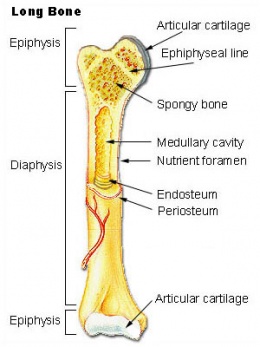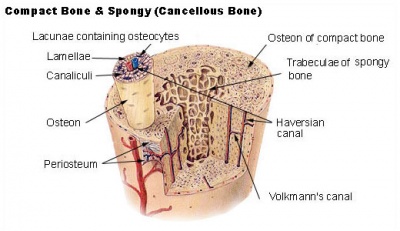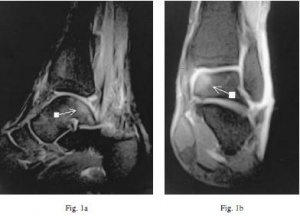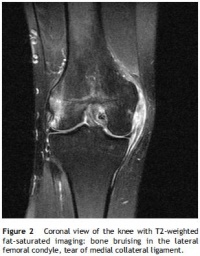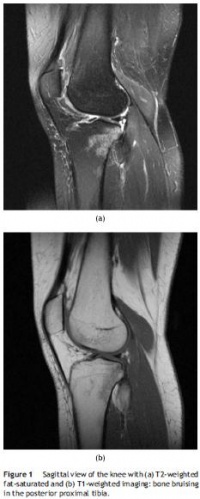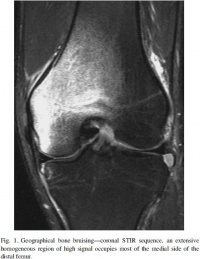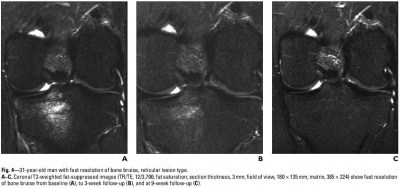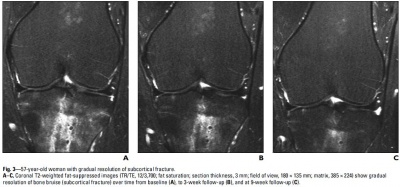Bone bruise
Original Editors - Laurien Henau as part of the Vrije Universiteit Brussel's Evidence-based Practice project.
Top Contributors - Laurien Henau, Claire Knott, Admin, Rik Van der Hoeven, 127.0.0.1, WikiSysop, Kim Jackson, Wanda van Niekerk and Lucinda hampton - .
Search Strategy[edit | edit source]
Search on PubMed, Science Direct, Web of Knowledge and Pedro with the keywords: “bone bruise”, “bone”, “posttraumatic AND knee”, “subperiosteal bleeding”, “hematoma” and “Magnetic resonance imaging of bones”.
The most successful keywords are: “bone bruise”, “MRI of bones” and “posttraumatic AND knee”
Definition/Description
[edit | edit source]
Bone bruise is one of the four types of fractures that occur in the human body, the others are: stress fractures, osteochondral fractures and bone fractures.[1]
Bone bruise is a term that contains 3 different kinds of bone injuries: sub-periosteal hematoma, inter-osseous bruising and sub-chondral lesion. [2]
A bone bruise can be described as a stage before the fracture.
When we speak of a real bone fracture it means that all the bone trabeculae of that specific place are fractured. In case of a bone bruise only a few of the trabeculae are broken.[3]
Clinically Relevant Physiology[edit | edit source]
The bone tissue is a specialized form of connective tissue. It contains 30% of collagen fibers, proteoglycans, 60% of Ca²+, 10% of H2O, cells and blood vessels.
There is an organic part (glycosaminoglycans) and an inorganic part (calcium and phosphate). [4]
Epidemiology /Etiology[edit | edit source]
“Bone bruise injuries have been reported frequently in the knee and also in the wrist, the calcaneus, the foot, ankle and in the hip.” [6]
There are all kinds of situations where a bone bruise can occur.
The most common causes are acute traumas in the knee or ankle.
In 80% of patients with an ACL rupture a bone bruise is detected, mostly in the femur condyles or in the tibia plateau. [1][4]
In the ankle bone bruises can appear after a supination injury, those will be situated in the post-lateral talus area (1a and 1b) or in the caudal tibia epiphysis (2a and 2b). [7]
A subperiosteal bleeding can also be related to hemophilia A or B. This can occur together with osteolysis.[8]
Characteristics/Clinical Presentation[edit | edit source]
There are 3 different kinds of bone bruises:
1. Sub-periosteal hematoma
This is a concentrated collection of blood underneath the periosteal of the bone. It will appear mostly after a direct high-force trauma on the bone. This type is most common in the lower extremities. [1][2]
2. Inter-osseous bruising
This is a damage of the bone marrow. The blood supply within the bone is damaged, and this causes internal bleedings. The trigger to this type of bone bruise is a repetitive high compressive force on the bone (extreme pressure on regular base).
The areas most affected are the knee and the ankle from professional athletes, such as foot-, basketball players and runners. [1][2]
3. Sub-chondral lesion
This type will occur beneath the cartilage layer of a joint. The main trigger is an extreme compressive force that literally crushes the cells, that results in a separation of the cartilage (or ligament) and the underlying bone, plus bleeding when the energy of the impact extends into the bone.
The other trigger is a shearing force, it sustains from a rotational mechanism such as twisting and translational forces. These will also cause that the cartilage tissue will be stripped away and exposing the underlying bone. It results in the same injury as a compressive force injury but this is another source of the injury.
This type is seen more frequently in foot- and basketball players.
For the three types: an extreme compressive force can include jumping or the impact from running on hard surfaces. [1][2]
Diagnostic Procedures[edit | edit source]
Bone bruises do not show up on X-rays, but an X-ray can confirm that a fracture is not present.
The diagnose of a bone bruise is mainly based on T2-weighted fat-suppressed images or T1-weighted imaging (MRI).This is the best way to find out whether the patient suffers from a bone bruise. [4]
Some examples of MR images
- in the ankle: cfr. 3 epidemiology.[7]
- in the knee:
Examination[edit | edit source]
There are a lot of studies that investigate the connection between an ACL tear and a bone bruise of the knee. “They identified bone bruising as the most important secondary signs for the diagnosis of ACL injury.” In the same studies they have also investigated the connection between MCL tear, medial meniscus tear and bone bruising. [1], [9] [2]:(Vellet AD et al., Mink JH. et al 1993, Mink et al 1989, Rosen MA et al) [4]
Another study was about the bone bruise appearance after supination injury of the ankle. This study showed that there was no significant relation between an ATF ligament injury and a bone bruise. The bone bruises in the ankle are common in uncomplicated injuries and have minor, if any, clinical significance. [7]
Patients with a bone bruise seem to have protracted clinical recovery, with more effusions and pain at matched time intervals and a slower return of motion. [1]
The best way to diagnose a bone bruise is with an MRI scan. [4]
Physical Therapy Management
[edit | edit source]
The treatment of a bone bruise consists of rest and precaution.
The affected area should be avoided to bear repetitive or strong loads.
This is to avoid aggravation of the problem. Usually only painkillers
(such as a small dosage of ibuprofen) are given to lighten the pain.
The patient should receive advise about how he could reduce the load on
the affected area and be made clear that if he does not rest enough the
healing process will slow down or the structure can be damaged even more. [10]
The time for the resolution of a bone bruise is variable. At its earliest the bruise will be gone 3 weeks after the acute trauma. In all cases the bone bruises disappeared at 2 years after the trauma.[1][2]
Resources
[edit | edit source]
- Web of Knowledge
- PubMed
- Pedro
- Science Direct
- Google Scholar
Recent Related Research (from Pubmed)[edit | edit source]
www.ncbi.nlm.nih.gov/pubmed/7803074
www.ncbi.nlm.nih.gov/pubmed/18094266
www.ncbi.nlm.nih.gov/pubmed/11368941
www.ncbi.nlm.nih.gov/pubmed/17715100
www.ncbi.nlm.nih.gov/pubmed/9228318
www.ncbi.nlm.nih.gov/pmc/articles/PMC2378166/
References[edit | edit source]
- ↑ 1.0 1.1 1.2 1.3 1.4 1.5 1.6 1.7 1.8 V. Mandalia, A.J.B. Fogg, R. Chari, J. Murray, A. Beale, J.H.L. Henson. Bone bruising of the knee. Clinical Radiology 2005; 60, 627–636 Grades of recommendation:A
- ↑ 2.0 2.1 2.2 2.3 2.4 2.5 2.6 V. Mandalia, J.H.L. Henson. Traumatic bone bruising – A review article, European Journal of Radiology 2008; 67; 54–61 Grades of recommendation A
- ↑ Janice Polandit, 5 Things You Need to Know About a Bone Bruise, 2011; http://www.livestrong.com/article/5521-need-bone-bruise/ Grades of recommendation F
- ↑ 4.0 4.1 4.2 4.3 4.4 L.C. Jungueira and J. Carneiro, “Functional Histology” 2010; 167
- ↑ http://www.daviddarling.info/encyclopedia/B/bone.html
- ↑ Christoph Rangger, Anton Kathrein, Martin C Freund, et al. Bone Bruise of the Knee. Acta Orthop Scand 1998; 69(3) : 291-294. Grades of recommendation B
- ↑ 7.0 7.1 7.2 7.3 Ville Alanen, Simo Taimela, Jaakko Kinnunen, Seppo K. Koskinen, Erkki Karaharju. Incidence and clinical significance of bone bruises after supination injury of the ankle. J Bone Joint Surg [Br] 1998;80-B:513-5. Grades of recommendation B
- ↑ Prof. Dr. S. Van Creveld and Dr. M. Kingma Subperiostal haemorrhage in haemophilia A and B. Ned. T. Geneesk. 105. I. 22. 1961; 1095-1098 Grades of recommendation F
- ↑ 9.0 9.1 Simone S. Boks, Dammis Vroegindeweij, Bart W. Koes, et al. MRI Follow-Up of posttraumatic Bone Bruises of the knee in General Practice. AJR 2007; 189:556–562 Grades of recommendation B
- ↑ The Basics of Bone Bruises; Grades of recommendation F http://bruises.knowingfirstaid.com/permalink.php?article=Bone%20Bruises.txt
